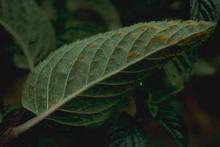Cause A fungus, Puccinia menthae, which overwinters on mint stubble and on wild and escaped mint. It completes its complex life cycle on one host (autoecious) and is macrocyclic (five spore stages), of which the aecial stage can be systemic in plants. Eleven races have been identified in the Pacific Northwest. Isolates from native spearmint are unable to infect peppermint, and peppermint isolates are unable to infect native spearmint. Isolates from both native spearmint and peppermint infect Scotch spearmint, but the peppermint isolates develop more slowly on Scotch spearmint than those from native spearmint. Peppermint rust is found frequently in western but not in central Oregon, while rust is a major disease on Scotch spearmint in central Oregon. Rust is found on native spearmint and Scotch spearmint in south-central Washington; however, it is not observed on peppermint due to high summer temperatures.
Symptoms Brown, circular pustules on the leaves' undersides followed by leaf yellowing and defoliation. A yellow spore stage (urediniospores) is in reddish blisters on young shoots in spring, and a black spore stage (teliospores) is on stems and regrowth in fall. Swollen shoots with elongated, chlorotic internodes are associated with systemic infection.
Cultural control
- Flaming (but do not flame Scotch spearmint) with propane in spring (April 1 to May 15) is absolutely necessary for rust control even if fields were flamed the previous fall. Flamer speed should be 2.5 to 3 mph; gas pressure should be 35 to 40 psi. Speeds less than 3 mph are wasteful; more than 3 mph reduces flamer's effectiveness. Complete flamer coverage is essential. It is not advisable to flame thin stands. Do flame escaped mint in field edges, fence rows, or any other unplowed place. To be most effective, flaming should be community-wide so rust will not spread from untreated to treated fields later in the season.
- After working fields in spring and when emerging mint shoots are 1 to 3 inches tall, plow under all stubble 3 inches or more. Flame soil surface with propane or other gas flame-type burners to burn back early-emerging young shoots.
- Early harvest (before leaves drop due to rust) may limit rust damage.
Chemical control
- Badge SC (Group M1) at 0.75 to 1.5 pints/A on 10-day intervals. Preharvest interval is 0 days. 24-hr reentry for greenhouse use; 48-hr reentry for all other applications.
- Demethylation-inhibiting (DMI) fungicides (Group 3) are labeled for use.
- Bumper 41.8 EC at 4 fl oz/A in a minimum of 20 gal of water. Begin applications when plants are 2 to 4 inches high or when conditions become favorable for disease. Make second application 14 days after the first application. Do not apply within 30 days of harvest. Oregon and Washington only, west of the Cascade Range. 12-hr reentry.
- PropiMax EC at 4 fl oz/A. Do not apply within 30 days of harvest. 12-hr reentry.
- Rally 40WSP at 4 to 5 oz/A on 14- to 21-day intervals. Do not apply within 30 days of harvest. 24-hr reentry.
- Tilt at 4 fl oz/A in a minimum of 20 gal water. Apply when plants are 2 to 4 inches tall and again 14 days later. Do not apply within 7 days of harvest. 12-hr reentry.
- Strobilurin fungicides (Group 11) are labeled for use. Do not make more than one (1) application of a Group 11 fungicide before alternating to a labeled fungicide with a different mode of action.
- Headline at 9 to 12 fl oz/A prior to disease development on 7- to 14-day intervals. Preharvest interval is 14 days. 12-hr reentry.
- Quadris Flowable at 6 to 15.5 fl oz/A on 7- to 10-day intervals. May be applied up to 7 days before harvest for processed mint and on the day of harvest for fresh mint. 4-hr reentry.
Note: Premixes of Group 3 + 11 fungicides are available for use.
- Quilt Xcel at 10.5 to 14 fl oz/A. Apply when plants are 2 to 4 inches high or when conditions become favorable for disease development. Make a second application 14 days later. Do not apply within 7 days for harvest. 12-hr reentry.
Biological Control Efficacy unknown in Oregon.
- Double Nickel LC at 1 to 6 quarts/A on 3- to 10-day intervals. Can be applied the day of harvest. 4-hr reentry. O
Reference Johnson, D.A. 1995. Races of Puccinia menthae in the Pacific Northwest and interaction of latent period of mints infected with rust races. Plant Disease 79:20-24.


